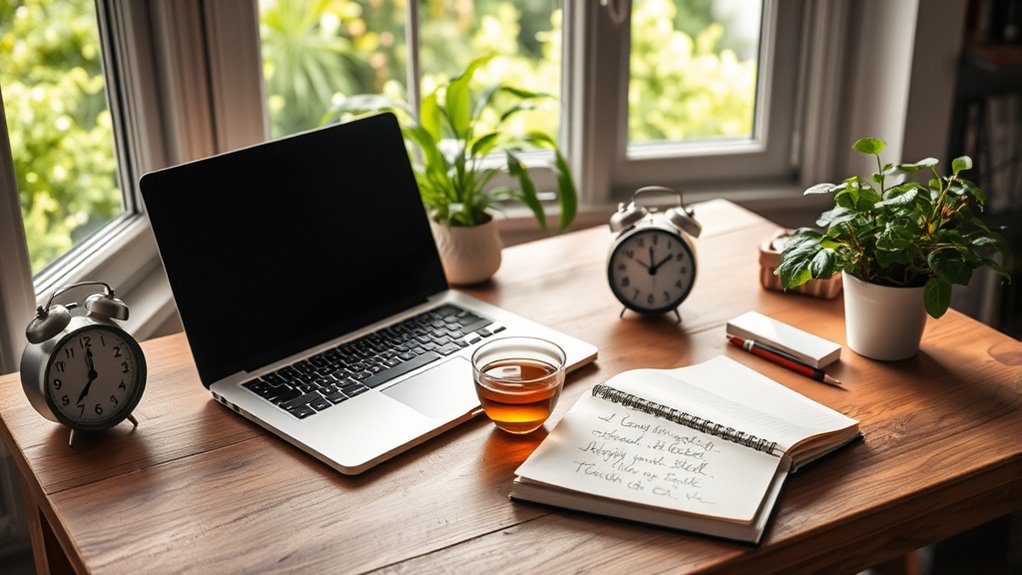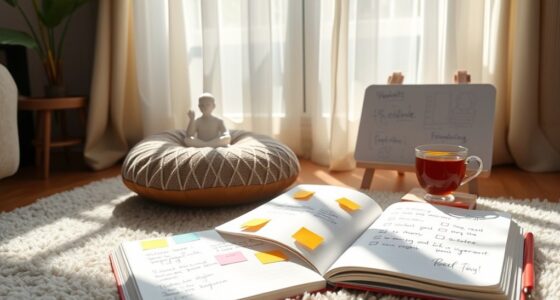To create a digital detox plan, start by evaluating your current screen habits and set realistic goals to reduce unnecessary usage. Establish boundaries by designating screen-free times and zones, like during meals or in bedrooms, and turn off notifications to minimize distractions. Fill your free time with offline activities such as hobbies or face-to-face interactions. Develop a calming routine before bed and stick to your limits; uncover more tips to restore balance.
Key Takeaways
- Track current screen time to identify overuse patterns and set realistic reduction goals.
- Establish specific disconnect times and designated screen-free zones to create boundaries.
- Prioritize offline activities like hobbies and face-to-face interactions to replace digital habits.
- Set app time limits and use controls to prevent aimless scrolling during online sessions.
- Develop a relaxing pre-sleep routine with activities like reading or mindfulness, avoiding screens before bed.

In today’s always-connected world, taking a break from screens can feel challenging, but creating a digital detox plan is essential for your well-being. Excessive screen time often leads to fatigue, reduced focus, and increased stress, especially when you spend hours scrolling through social media. To regain control, start by evaluating your current habits. Track how much time you spend on your devices daily, paying close attention to your social media usage. Recognizing patterns helps you identify areas where you can cut back and set realistic goals for reducing your overall screen time.
Assess your daily screen habits to identify patterns and set realistic goals for reducing screen time.
Next, establish clear boundaries around your device use. Decide on specific times to disconnect, such as during meals, an hour before bed, or during family activities. Turning off notifications can greatly reduce the temptation to check your phone constantly, especially social media alerts that tend to draw you in repeatedly. Consider designating certain spaces in your home as screen-free zones, like the dining area or bedroom, to encourage more face-to-face interactions and restful sleep.
Creating a schedule that prioritizes offline activities is key. Fill your free time with hobbies, exercise, or spending quality time with loved ones. Engaging in activities that don’t involve screens helps reset your mind and reduces reliance on digital devices. When you do go online, be intentional. Limit your social media sessions to specific times, and avoid aimless scrolling by setting time limits on apps. Using app timers or parental controls can help enforce these boundaries, making it easier to stick to your plan.
Another important step is to establish a technology-free wind-down routine before bed. Exposure to blue light from screens hampers your sleep quality, and social media can be particularly stimulating. Instead, opt for relaxing activities like reading a book, journaling, or practicing mindfulness. This not only improves your sleep but also reduces the temptation to keep checking your devices late into the night. Additionally, choosing home entertainment options like a home theatre setup or a good book can make your offline time more enjoyable and fulfilling.
Frequently Asked Questions
How Long Should My Digital Detox Last?
You might wonder how long your digital detox should last. It depends on your screen time and how device boundaries impact your daily life. Start with a short break, like a weekend, to reset habits and reduce stress. If needed, extend it gradually to a week or more. Listen to your mental and physical cues, and modify the duration to ensure you feel refreshed and more mindful about your device use.
Can I Still Use Essential Apps During the Detox?
Think of your digital detox as a chance to hit pause, like a painter stepping back from their canvas. During this time, you can still use essential apps if they fall under your app restrictions, but avoid non-essential ones. Consider app replacements that support your detox goals—like replacing social media with journaling or meditation apps. This way, you stay connected to what matters without getting sidetracked, making your detox more effective.
What Are Alternative Activities to Replace Screen Time?
Instead of screen time, you can try mindful breathing exercises to relax and center yourself. Outdoor adventures like walking, hiking, or biking offer invigorating activities that get you moving and help disconnect from screens. Engaging in hobbies such as reading, cooking, or gardening also provides fulfilling alternatives. These activities boost your well-being and make your digital detox more enjoyable, helping you establish healthier habits and a balanced lifestyle.
How Do I Handle Work Emails During a Detox?
Imagine your work emails as a garden that needs regular tending. During a detox, set clear email boundaries—check only at scheduled times and avoid constant notifications. Communicate your plan to colleagues, so they respect your boundaries. This approach helps you maintain work communication without feeling overwhelmed, allowing you to enjoy your digital detox fully. Prioritizing this balance ensures you stay productive while reclaiming your mental space.
What if I Experience Withdrawal Symptoms?
If you experience withdrawal symptoms like caffeine withdrawal or sleep disturbances, don’t panic. You can ease these by gradually reducing your screen time instead of stopping suddenly. Stay hydrated, get plenty of sleep, and incorporate relaxing activities like reading or meditation. Remember, withdrawal symptoms are temporary, so be patient with yourself and give your body time to adjust. This approach helps you stay committed to your digital detox.
Conclusion
By gently setting aside your devices, you allow yourself to reconnect with what truly matters. This intentional pause isn’t about retreating from technology, but embracing a quieter space where your mind can breathe and your spirit can renew. As you gradually find balance, you’ll discover moments of clarity and calm that remind you life’s richness isn’t just a click away. Sometimes, the best way forward is simply stepping back and letting yourself be present.









